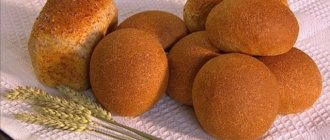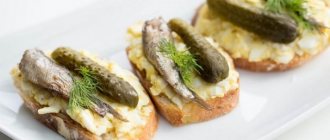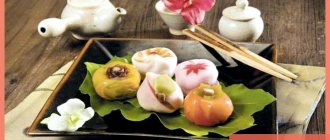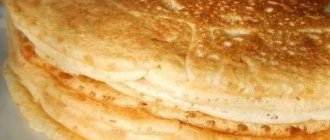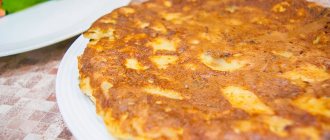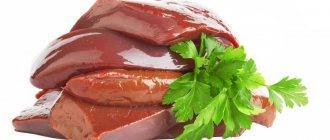Wheat bread makes up the majority of all baked goods. For its production, different types of wheat flour are used. It is believed that the healthiest bread is made from wholemeal flour, but it is less common on the shelves. In addition to the main components, bran, nuts, raisins and flavorings can be added to the finished product. At home, you should try making bread from wheat flour, which will contain only healthy ingredients.
On this topic:
Tasty and healthy - preparing viburnum jam for the winter
Aug 23, 2020
How to make apple cider at home -...
Aug 19, 2020
We reveal the secrets of how to properly ferment cabbage for the winter
Aug 19, 2020
A piece of sunshine in a jar - pumpkin juice, recipe in...
Aug 6, 2020
BACK FORWARD 1 of 132
Why is it useful?
The composition of the product complies with the principles of proper nutrition. The rye grains from which flour is made contain:
- proteins;
- amino acids;
- vitamins A, groups B and E;
- salt;
- minerals
- cellulose.
Previously, malt, honey, and spices were added to the dough for rye bread. It is not without reason that bread became the main source of vitamins during Lent.
Rye baked goods contain five times more fructose than products made from wheat flour. The fiber that this product is rich in cleanses the intestines: it absorbs toxins and removes them, “feeds” beneficial microorganisms. The calorie content of rye bread is low, but it quickly satisfies the feeling of hunger - this allows you to include it in diets.
Preparation
To begin, place the listed ingredients in the bread machine container. The molasses must first be dissolved in water. Select a program for whole wheat bread and a medium crust.
Due to the presence of microelements, fiber and other benefits contained in whole grain flour, this product is suitable for people who choose a healthy diet. It must be emphasized that it normalizes intestinal function and also helps cleanse the human body of toxins.
How the product is made
In Ancient Rus', they baked a yeast-free rye loaf with sourdough. The taste and aroma of the product depended on its quality. Today, similar technology is used in the industrial production of the product.
Dough made from rye flour is inelastic due to a lack of gluten. The lactic acid bacteria contained in the leaven loosen it and make it elastic.
Rye flour is slightly darker than wheat flour, which is why the finished bread has long been called “black”. However, products made from it are considered difficult to digest. Because of this, bread dough is often “watered down” with white flour.
Range
Bread is classified according to the amount of wheat flour:
- pure rye;
- gray (rye-wheat or wheat-rye).
According to the composition of the starter, the finished product is:
- unleavened (without leaven);
- leavened (the dough is kneaded using yeast-free sourdough);
- yeast (“industrial bread”).
By type of finished product:
- tin bread (rye loaf, black loaf);
- rye hearth (round shape; the name comes from the bread baked on the “hearth” of the oven).
Based on the composition of the test, there are:
- plain bread (no additives);
- custard (with sugar, molasses, spices, malt).
The range of rye baked goods is complemented by whole grain bread made from wholemeal flour. Everything that remains after grinding gets into the dough of this product. This technology allows you to preserve nutrients concentrated in the shell of the grains.
Types of flour
According to the grinding method, there are four types of rye flour:
- wallpaper (similar to whole grain; husks and debris are sifted out during grinding);
- peeling;
- sifted (fine grind);
- peklevanny (the name probably comes from the sifting process).
The smaller the number of flour sifts, the richer the finished product in vitamins.
Old and new recipes
The industry produces several types of rye bread.
The classic bread recipe includes first grade peeled rye and wheat flour, sourdough, salt and water.
Borodinsky choux bread, baked with the addition of wheat flour and bitter spices, according to one version, was named in honor of the fallen heroes of the Patriotic War. The recipe includes rye flour, sourdough prepared on it, second-grade wheat flour, malt, molasses, coriander, caraway seeds, anise, sugar, salt.
A mixture of rye flour and whole grain wheat is the basis of “Orlovsky” bread. The product is baked from low-grade flour, the taste of the finished product is sour.
Another type of custard bakery product is “Moscow” bread. The starter for it is prepared from rye wallpaper flour with the addition of malt and molasses.
homemade baking
Bread can be prepared with sourdough or yeast by adding whole grain flour, seeds, and dried fruits to the dough.
Russian soda rye bread, created on the basis of the Irish recipe of the same name, is distinguished by the fact that yeast or sourdough in it is replaced by dairy products - kefir, buttermilk or cream. The dough for such a loaf rises quickly, and baking takes a little time.
The first leaven for Tatar rye ikmek, as for Russian bread, is traditionally placed on hop cones, and for each new baking, a piece of dough left over from the previous preparation is taken.
“Knead quickly, but sit for a long time” - this is the principle used to prepare a rye loaf. The final product contains a minimum of calories, however, it contains baker's yeast.
Foreign recipes
Rye bread is valued not only in Russia. This product is the national pride of modern Finland. The demand for loaves made from wheat flour is small here.
Finnish bread is baked from unrefined rye grains, and bran is added to the dough. The traditional recipe does not contain other additional components, but the baking form is varied: from crispy bread to round flat cakes with a hole (reikäleipää).
Danish grain bread is baked on rye sourdough with the addition of honey or molasses, beer, seeds, and soaked grains.
The Irish often bake traditional yeast-free soda bread by mixing three types of flour (you can bake with just rye). Soda, kefir, wheat bran, and spices are added to the dough.
For a French baguette, mix two types of flour in a ratio of 1:2 or 1:3 (there should be more wheat flour), add malt or spices. A ready-made rye baguette with a traditional crispy crust tastes like Darnitsky or Borodinsky bread.
Preparation
This wheat bread must be baked immediately after all the ingredients have been placed in the bread machine container.
Mix yeast with 160 g of flour, sugar and salt. Place all other ingredients in the bread machine container in the following order: water, butter, remaining flour, eggs, and the resulting mixture with yeast. Switch on the program for baking butter/sweet bread, select a medium crust. After a little time, you will be able to appreciate how tasty this wheat bread is.
Same as before
Bread according to a traditional recipe is baked in the same way as regular bread, but instead of yeast, sourdough is added to the dough. Its ripening lasts from three to six days.
Sourdough is made on the basis of:
- raw rye grain;
- boiled grain;
- raisins;
- rice;
- hop cones.
Rye sourdough, unlike wheat, does not sour and responds well to “feeding”. Part of it is taken for dough, and the rest is stored in the refrigerator.
Sourdough on rye grains
The starter is prepared within three days. It will require:
- 2 tbsp. rye flour;
- a glass of grain;
- warm water;
- 1 tsp granulated sugar/honey.
A glass of grain is soaked and placed in a warm place for germination. In the evening of the second day, the mixture is ground and the remaining components are added to it. Then the container is covered and returned to its place.
On the third day, part of the starter can be used for dough.
“Boiled” on grains
The basic procedure and ingredients are the same as for sourdough with raw grains. On the second day after grinding, the mixture of components is boiled over low heat for 20 minutes (you can add water).
Rice starter
The starter takes six days to prepare. It includes:
- 100 g rice;
- 250 ml of heated water;
- 3 tsp granulated sugar
- 8-9 tbsp. wheat flour.
Pour 150 ml of water into the rice, add 1 tsp. sugar and put the mixture in a cool place for three days.
On the third day, add 3.5 tbsp. spoons of flour, tsp. granulated sugar.
On the fourth day, the starter is mixed, 100 ml of water and 1.5 tbsp of flour are added. The next day, filter it, add tsp. sugar and 4.5 tbsp. flour. After 2-3 hours you can prepare the dough.
Hop cones
Sourdough using hop cones takes five days to prepare. It will require:
- 1 tbsp. hop cones (dry);
- a glass of boiling water;
- heated water;
- 1 tbsp. sugar/honey;
- thermos;
- jar (2 l).
In the evening of the first day, pour pine cones into a thermos and pour boiling water over them. The next day, the hop infusion is filtered into a jar, sugar is added and stirred with flour until it becomes thick sour cream. The starter is covered with a towel and kept warm.
On the third day, the surface of the mixture will be covered with foam. The leaven will have an unpleasant smell, and it will become liquid. With the help of flour, it is returned to its previous thickness and again placed in a warm place.
On the fourth day, add water 1/2 or 1/3 of the volume of the starter, mix and add flour again. On the fifth day the procedure is repeated.
On the sixth day, part of the starter is taken for dough.
The rest of the starter is fed: water and flour are added until the previous volume and density are restored.
Opara
To prepare the dough you will need:
- a glass of sourdough;
- sifted flour;
- 350-500 ml of heated water.
The starter should “gain strength”. To do this, it is mixed with flour and water to form a batter and left in a warm place overnight. During this time, the dough increases in volume. By morning it begins to fall: it’s time to start preparing the dough.
Dough
For the test you will need:
- 1 kg rye flour;
- 100 g wheat flour;
- 1 tsp salt;
- 2-3 tbsp. sunflower oil;
- 1 tbsp. honey
- 0.5 tbsp warm water.
Honey and salt diluted in water are poured into the dough, bran, spices to taste (cloves, ginger, coriander), raisins, seeds, nuts, etc. are added.
Pour butter into the dough, add sifted rye flour.
The dough is kneaded on a table sprinkled with wheat flour. There should not be too much flour, otherwise the consistency will be too dense. The rye dough will not stop sticking to your hands, so you can knead for a while (about 15 minutes).
The dough is formed into a ball, which is placed in a greased pan and left warm for 1-3 hours.
Bake bread for 40-60 minutes at a temperature of 220-230°C. You can place a bowl filled with water at the bottom of the oven.
After baking, the bread sits for a day. If you hear a hollow sound when you tap the bottom of the loaf, it is baked correctly and is ready to eat.
Challah
You will need:
- cooled melted butter (60 g);
- hot water (200 ml);
- beaten eggs (2 pcs.);
- wheat flour (500 g);
- salt (5 g);
- dry yeast (1.5 tablespoons);
- sugar (60 g).
This is a traditional Sabbath holiday Jewish wheat bread. Fragrant, light, nutritious, airy, soft challah is delicious on its own and is also great for sweet sandwiches.
Whole wheat bread
“The product is gray-brown in color, dense, heavy, moist, does not crumble.” If the loaf matches this description, then it contains at least 50% coarse flour - due to its large particles, the dough does not rise well. You can bake this healthy, vitamin-rich whole grain rye bread yourself.
To prepare you will need:
- 300 g whole grain flour;
- 200 g wheat flour;
- 1 tsp. salt;
- 150 g of rye sourdough fed for 10-12 hours;
- 300 ml water;
- 1 tbsp. l. honey;
- 1 tbsp. l. crushed mixture of spices (cumin, rosemary, dill);
- cereals.
Knead the thick dough by hand for 10 minutes. Then it is placed in a bowl, covered with a cloth and put in a warm place for 2-3 hours. The settled dough is kneaded again, formed into a loaf, sprinkled with oatmeal, placed in a mold and left for an hour.
Bake the bread for 10 minutes at 220°C. Then another 40-50 minutes at 200°C. If there is a bowl of water in the oven, the product will be more moist.
Italian wheat-rye bread
You will need:
- vegetable oil (1 tablespoon);
- water (400 ml);
- wheat flour (240 g);
- salt (1.5 teaspoons);
- rye flour (240 g);
- a pinch of ascorbic acid;
- dry yeast (1.5 tablespoons).
Wheat-rye bread is distinguished by an airy, tender, melting, elastic crumb hidden under a crispy thin crust. An excellent breakfast product, as it is very convenient to dip into sauce or jam, and also to make delicious sandwiches with it.
Traditional methods of treatment
Rye bread has long been used in folk medicine as a cure for many diseases.
For insomnia, it is advised to crumble two identical pieces of white and rye bread, add 1 tbsp. curdled milk, a small amount of cucumber pickle, finely chopped pickled cucumber. The finished mixture is wrapped in gauze and applied to the forehead and temples in the morning and evening for a quarter of an hour.
To get rid of diarrhea, soak a couple of pieces of bread in cold water (0.5 l) and leave in a cool place for 2-3 hours. The strained infusion is drunk every hour, half a glass.
To treat worms in children, sprinkle garlic-rubbed bread crust with salt and eat it in the evening before bed, without drinking water. The same recipe, but without garlic, is recommended in folk medicine for childhood enuresis.
For severe headaches and eye diseases, wash the plantain along with the roots and squeeze out the juice, which is used to soak pieces of black bread. They are applied to the temples or left on the eyes for 15 minutes.
Two pieces of rye bread, greased with olive oil and applied to the temples, will relieve migraine pain.
Treatment of acne and boils with rye bread lotions
In order for the boil to open and heal, a chewed piece of bread is applied to it and secured with a bandage.
For the nose and throat
For a runny nose, folk medicine recommends daily frying a piece of rye bread in a dry frying pan until it burns and inhaling the smoke, pinching your nostrils alternately.
To treat a sore throat, scald a thin piece of bread crust with boiling water. It is applied to the neck, pressed with a compress, which is secured overnight with a woolen scarf.
To get rid of herpes, gruel from a small piece of bread, 1 tsp. salt and boiling water are regularly applied to the inflamed area for an hour.
For colds and flu, it is useful to eat rye crust rubbed with garlic twice a day.
It is important to remember that the symptoms of diseases are a signal indicating disturbances in the functioning of the body. Traditional medicine may bring temporary relief, but internal problems will remain. Consulting a doctor will help determine the cause of the disease and begin treatment on time.
Black bread in medicine
Not only traditional medicine recognizes bread as a healing product: doctors recommend it for the treatment of diseases associated with the digestive tract and other body systems.
Rye bread is useful for:
- lack of vitamins;
- low hemoglobin level;
- metabolic disorders;
- disorders of the gastrointestinal tract system;
- diseases of the nervous system;
- gout;
- overweight.
In the latter case, black bread is especially useful: cholesterol levels decrease with the removal of toxins.
Yeast-free rye bread with bran has an anti-inflammatory effect and is useful for dysbiosis. Eating a daily dose of whole grain bread is recommended for heart disease and cancer.
Refusal of this product will deprive the body of the main source of vitamin B, which is responsible for stress resistance, regulation of the nervous system, and the production of serotonin. The intake of iron, phosphorus, manganese, and iodine will also be reduced.
Natural cosmetic
Our ancestors noticed that mixtures based on rye bread applied to the face or head helped to improve skin health, get rid of acne, and restore strength to hair. Ancient recipes have changed a little, but are not outdated.
For masks, bread crumbs with the addition of oils and honey are usually used. The main condition for preparation: grind the bread well (the safest way is with a blender), and also soften it (soak it in water - mineral or regular, in chamomile infusion).
The components of the finished cosmetic mixture are inexpensive, but truly effective.
Skin cleansing
The minerals contained in flour will help refresh your skin color and remove fine wrinkles. To do this, apply flour to the face after a shower for 10-15 minutes.
To treat acne, prepare a paste from a piece of rye bread, 1 tsp. honey and apply it to problem areas twice a week for a quarter of an hour. Add 1 tbsp to the mixture for dry skin. olive oil.
Additional ingredients will help achieve exfoliating and anti-inflammatory effect. Such procedures tighten and dry the skin, saturate it with antioxidants, and improve blood circulation.
1. To prepare a scrub mask you will need:
- 2 tbsp. sour cream;
- 100 grams of soaked bread.
The mixture is applied to the face in circular motions from the chin to the forehead.
2. A mask with an anti-inflammatory effect consists of:
- 2 tbsp. with a pile of bread crumbs;
- 1 tbsp. honey.
The cakes from the mixture are left on problem areas for 10-15 minutes.
For hair beauty
It is recommended to apply nourishing masks made with rye bread if your hair:
- look dry, brittle or, on the contrary, greasy;
- dull, fall out quickly;
- easily tangled.
To achieve the best effect, apply the mask shortly before washing your hair. Gluten contained in rye flour makes hair smooth and easier to comb. The properties of the scrub improve blood circulation and strengthen the roots. An additional plus: these masks are suitable for all hair types.
To evenly distribute the mixture throughout your hair, it is better to use a wooden comb. After applying the mask, the head is covered with a cellophane cap. It is advisable to warm yourself during the procedure.
The masks are washed off thoroughly, making sure that no crumbs remain on the head. A herbal decoction is suitable for rinsing.
Some masks can be used daily, but usually they are used 1-2 times a week.
1. The simplest mask for hair restoration consists only of rye bread and hot water. It will require:
- 800 g bread crumbs;
- hot water (up to 70-80°C).
The bread is completely filled with water and left for 5-6 hours in a container closed with a tight lid. Apply the mixture to clean and dried hair, then massage into the head. The mask lasts for 30 minutes.
2. To increase hair thickness, mix:
- rye crumb;
- 1 tbsp. olive oil;
- 1 tbsp. burdock oil.
After application, the mask is left on the head for 30 minutes.
3. For a mask that stops hair loss, you will need:
- decoction of herbs (sage, chamomile and plantain in a ratio of 1:1:1);
- rye crumb.
The herbs are brewed with boiling water, left for half an hour and filtered. Then the crushed crumb is soaked in the resulting infusion for 3 hours. The mashed mixture is rubbed into the head.
4. The second mask for hair loss is prepared from kefir:
- 0.5 l of kefir;
- 200 g rye bread.
The mixture for the mask is infused for 4 hours, then crushed with a blender and applied to the head for 30 minutes.
5. To prepare a mask that promotes hair growth, take:
- 200 g rye bread;
- 1 egg;
- lemon juice;
- 1 clove of garlic.
The bread is soaked, the egg is beaten, then the ingredients are mixed. After half an hour, lemon juice is poured into it. Separately prepare lemon water for rinsing after washing.
The mask is applied for 30 minutes.
Hair masks are varied: when preparing, you can enrich them with nourishing oils (burdock, castor, coconut, olive), as well as essential oils (lavender). Mustard powder, nettle, honey, ginger, bay leaf are added to some mixtures).
The components included in the mixtures are harmless, but they cannot be used if you are allergic to honey, grains, etc.
